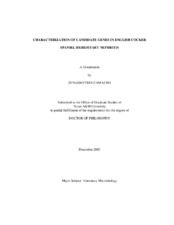| dc.contributor.advisor | Templeton, Joe | |
| dc.creator | Camacho, Zenaido | |
| dc.date.accessioned | 2005-02-17T21:07:05Z | |
| dc.date.available | 2005-02-17T21:07:05Z | |
| dc.date.created | 2003-12 | |
| dc.date.issued | 2005-02-17 | |
| dc.identifier.uri | https://hdl.handle.net/1969.1/1600 | |
| dc.description.abstract | Six different isoforms of Type IV collagen (colIVα1-6) have been identified. The individual isoforms of colIV are termed alpha chains and are translated from six different COLIV genes (COLIVA1-A6). Collagen Type IV gene products compose the structural framework of basement membranes. The glomerular basement membrane (GBM) is a specialized basement membrane involved in the ultrafiltration processes of the kidney. The colIVα1-α5 chains are expressed in the human GBM while the colIV α1-α6 chains are expressed in the canine GBM. Many inherited diseases of the kidney have been reported and mutations in genes regulating kidney function have been identified. Alport syndrome (AS) is the most common form of human hereditary nephritis (HN). AS is defined as an inherited progressive kidney disorder associated with sensoneural deafness and is characterized by extensive thickening and multilamminar splitting of the GBM when examined by electron microscopy. AS has both X-linked (XLAS) and autosomal (ARAS) modes of inheritance. Mutations in the COLIVA5 gene are responsible for XLAS. A form of HN with characteristic splitting of the GBM with X-linked inheritance has been described in Samoyed dogs. A specific mutation in the COLIVA5 gene has been identified in Samoyed dogs affected with HN. Mutations in the COLIVA3 and COLIVA4 genes are responsible for ARAS. A form of HN has been identified in English cocker spaniel dogs (ECS) that has been described as autosomal in inheritance and includes GBM abnormalities including extensive lammination characteristic of ARAS. Both ARAS and ECS-HN show loss of the colIVA3 and colIVA4 chains in the GBM when examined with monoclonal anitibodies. ECS-HN has been hypothesized to have the same molecular basis of disease as ARAS. As such, we have isolated and characterized canine COLIVA3 and COLIVA4 sequences from normal dogs and ECS dogs affected with HN and compared the coding regions of these candidate genes. | en |
| dc.format.extent | 353792 bytes | en |
| dc.format.medium | electronic | en |
| dc.format.mimetype | application/pdf | |
| dc.language.iso | en_US | |
| dc.publisher | Texas A&M University | |
| dc.subject | kidney disease | en |
| dc.subject | english cocker spaniel | en |
| dc.subject | collagen gene | en |
| dc.title | Characterization of candidate genes in English cocker spaniel hereditary nephritis | en |
| dc.type | Book | en |
| dc.type | Thesis | en |
| thesis.degree.department | Veterinary Pathobiology | en |
| thesis.degree.discipline | Veterinary Microbiology | en |
| thesis.degree.grantor | Texas A&M University | en |
| thesis.degree.name | Doctor of Philosophy | en |
| thesis.degree.level | Doctoral | en |
| dc.contributor.committeeMember | Busbee, David | |
| dc.contributor.committeeMember | Lees, George E. | |
| dc.contributor.committeeMember | Womack, James E. | |
| dc.type.genre | Electronic Dissertation | en |
| dc.type.material | text | en |
| dc.format.digitalOrigin | born digital | en |


